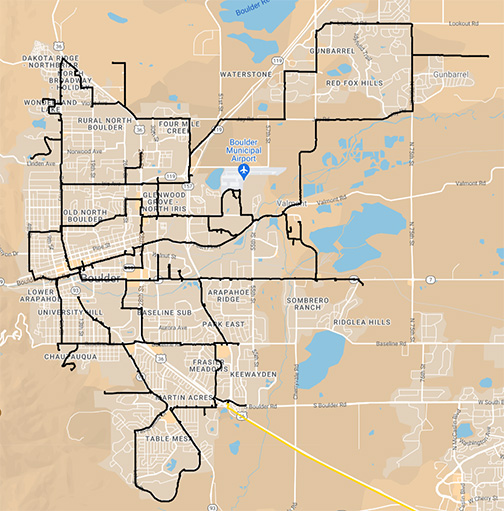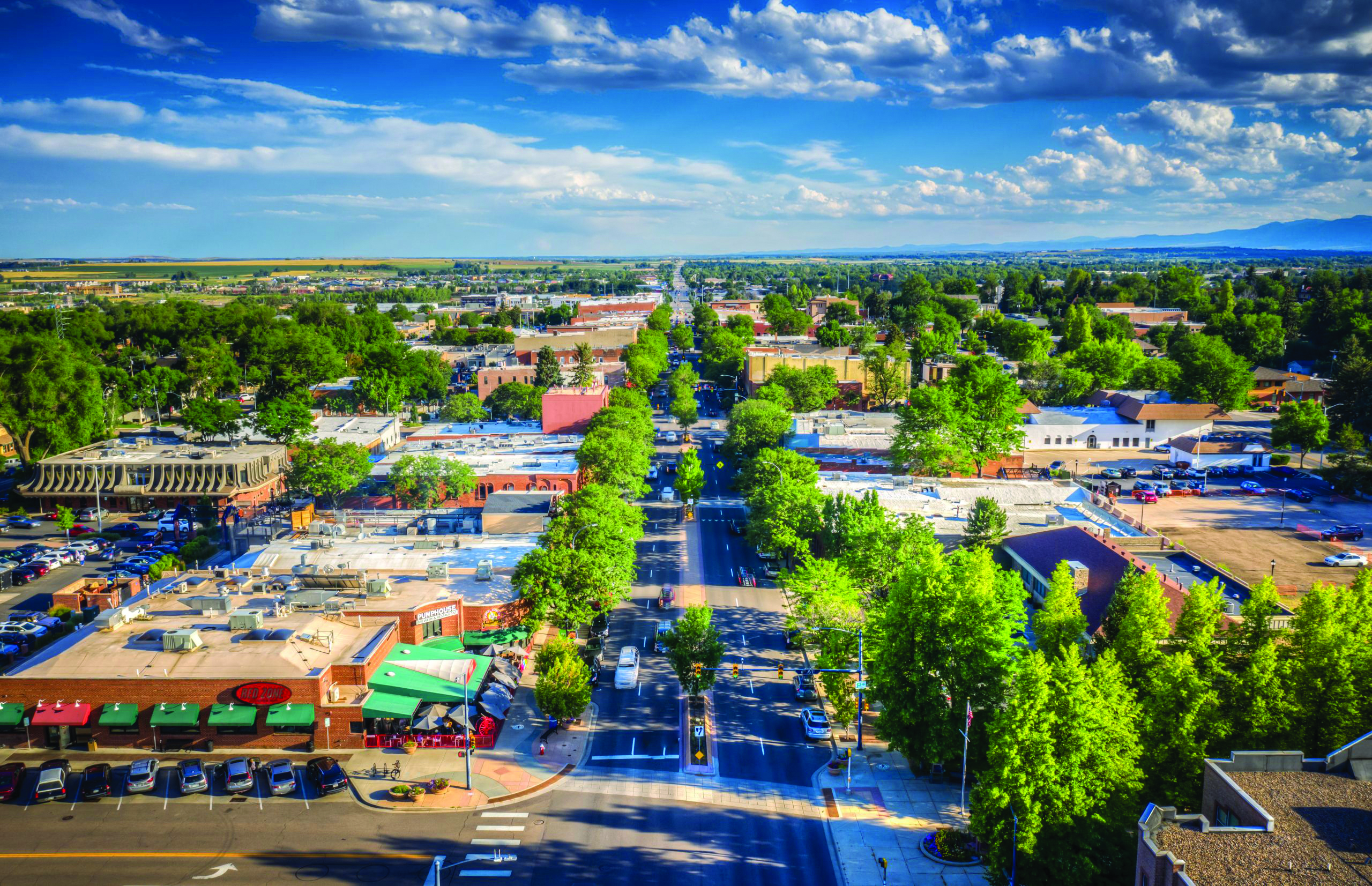
Boulder likes to think of itself as a tech hub. It’s home to giants of the internet age like Google, IBM and Apple. But there are few choices when it comes to internet providers. About two-thirds of Boulder residents have only one option — Xfinity through Comcast — and the other third also have the option of CenturyLink through Lumen.
That could be changing as soon as 2026, thanks to the City’s community broadband project. In October, Boulder’s city council unanimously agreed to start pursuing negotiations with a private partner that will lease the City’s fiber backbone in a move the City hopes will provide fast, reliable internet service at an affordable rate to all of Boulder.
“A lot of communities have realized that we’re not going to just continue to beg the national service providers to provide universal access to fast, reliable, affordable broadband. We’re gonna build it ourselves,” says Sean Gonsalves, a researcher and reporter for the Institute for Local Self-Reliance’s Community Broadband Networks initiative.

Boulder is set to complete construction on an underground 65-mile, 432-strand fiber backbone this year, which is the core infrastructure needed to deliver fiber-based connectivity. In addition to retail internet, the fiber can deliver 5G connectivity and SMART city applications using real-time data for things like intelligent traffic management, energy efficiency measures and more.
“All of those types of applications need internet connections in order to function,” Mike Giansanti, Boulder’s innovation and technology deputy director says. “Our fiber can provide the most reliable internet connection for that.”
Boulder will be joining the ranks of more than 900 communities across the country with some form of community broadband, according to the Institute for Local Self-Reliance.
“We’ve been delivered a broken broadband market where folks are beholden to monopoly internet service providers, where folks don’t have much choice or there’s not much competition in the market, which directly affects prices, quality of service and reliability,” Gonsalves says.
Since more than 99% of Boulder residents already have internet access, one of the project’s main goals is to increase competition, according to Giansanti.
“We believe strongly that infusing additional competition into the market will not only help with price stabilization and affordability and competition on rates, but it’ll also help on investment in infrastructure from those incumbent providers,” Giansanti says.
Why a lease?
So far, Boulder has spent $20 million on the 65-mile backbone. While the City explored a municipal network, building out the project to be fully City-owned and operated would have required another estimated $290 million, subsequently doubling the City’s debt, requiring higher taxes and reducing general fund services, according to projections in an Aug. 24 memo.
By leasing the backbone to a third-party provider, the City anticipates no additional costs to taxpayers. The Aug. 24 memo called that option Boulder’s “most feasible and lowest risk approach.” The service provider would also fund, construct and own the middle- and last-mile infrastructure, which connects homes and businesses to the backbone and service.
“The analogy that I’ve given over and over is we essentially built the interstate,” Giansanti says. “We have enormous capacity to carry data and internet products over the 65 miles that we’ve built, and the highway has been built throughout the entire city. What we haven’t built is the off ramps to the main roads and side streets and driveways.”
While some community members and council members voiced reservations about a private partner as opposed to a municipal network earlier in the project, elected officials ultimately voted unanimously in favor of a private partner lease and right-of-way agreement.
It’s possible that could mean multiple partners leasing the backbone, including providers, businesses and schools. The City plans to reserve half of the fiber for its own use, Giansanti says. Already, there are some traffic signals and some public safety communication infrastructure connected to the backbone.
“We want to see all our 432 strands of that fiber be lit up for different purposes,” he says.
A City-owned fiber leased to private companies also has the potential to generate revenue for the City, depending on the terms of the lease, Giansanti says.

Gonsalves calls public-private partnerships a “viable and important approach to solving the digital divide.”
“The important thing, I think, is that the City decided to take action into their own hands and create the infrastructure and also had the foresight that they weren’t in the position necessarily to deliver the retail service,” Gonsalves says, adding that having the backbone in place lowers the cost and other barriers for small and mid-sized providers that are often more invested in the community.
“It’s a different level of accountability, it’s a different level of pride in terms of delivering service,” he says. “As opposed to when you’re in a monopoly situation, of course, people get treated as such.”
A brief history
Boulder’s journey toward community broadband arguably began nearly a decade ago, when voters opted out of Senate Bill 152, a bill passed in 2005 that prohibits municipalities from providing broadband but includes a provision that allows voters to opt out. Then, Council voted to fund and construct the backbone in 2018.
Gonsalves calls Colorado “a hotbed for municipal networks.” More than 120 municipalities have opted out of SB152 as of November 2022, according to Colorado Municipal League. In 2023, the bill was repealed as state officials were unsure of whether communities that hadn’t opted out would be able to qualify for federal funds coming the state’s way through the Broadband Equity, Access and Deployment program.
Longmont, Fort Collins and Loveland, to name a few, have municipal networks that are owned and operated by the city. Other communities, like Centennial, have leased their backbone to private companies such as Ting, a fiber internet provider that currently serves less than two dozen towns in California, Colorado, Idaho, North Carolina, Maryland and Virginia.
It’s not always certain that a new provider will be cheaper for residents than incumbent services. In Centennial, for example, Ting advertises light speed fiber internet for $89 per month, while Xfinity advertises $65 per month at some addresses for the same speed (1000 MBPS).
Most households in Boulder currently pay between $50 and $75 for internet services, according to a survey by BBC Research and Consulting cited in the Aug. 24 memo.
Giansanti says the City will also require any partner to participate in the Affordable Connectivity Program, a Federal Communications Commission program that provides up to $30 in monthly discounts on internet service for households below 200% of the federal poverty line or participating in certain assistance programs like SNAP or Medicaid. Comcast and CenturyLink also participate in the program, which is used by an estimated 2,500 households in Boulder, according to the memo.
What’s next?
Having certain safeguards in place within the lease is important in ensuring the project actually achieves its goals, Gonsalves says.
“There are public-private partnerships in name only,” he says. “And then there’s real public-private partnerships, meaning that the municipality has some real skin in the game, and therefore they have leverage and a seat at the table in terms of saying, ‘This is what we’re looking for.’”
Communities should also have contingency plans in case the ISP leasing the backbone is bought out or goes out of business, as consolidation of providers can lead back to where the city started. For example, Gonsalves says the City could negotiate a first right of refusal.
While the incumbent service providers will have the ability to apply for the lease, Giansanti says infusing competition into the market will be a key part of the selection process.
After an initial Request for Information to explore potential partners issued in March, Giansanti says the City received eight responses, five of which could be viable options. As the lease is negotiated, Giansanti will meet with council members on an individual basis.
“We’ll likely have some non-economic items that we’ll negotiate for, including the objectives that we’ve laid out in front of council, which include net neutrality and privacy, building out to the full city — affordability is at the center of all that, and so we will be bringing that to the table to negotiate in exchange for use of our backbone, which is an incredible asset.”
The hope, Giansanti says, is to have a deal in place with a third-party provider by the end of next year. Design will hopefully begin in 2025, with construction beginning in 2026 and customers beginning to be served that same year.



